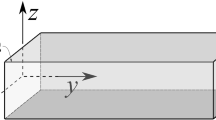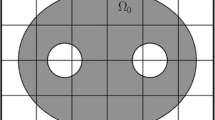Abstract
This paper is concerned with the application of standard 3D Boundary Element Methods to solve thin-walled structural elements (needle-like/shell-like solids). A subregion-by-subregion data structure, incorporating iterative solvers and discontinuous boundary elements, is presented. To efficiently and accurately evaluate the quasi-singular integrals, special quadrature methods are applied. In addition, structured matrix-vector products, designed to avoid the excessive number of conditional tests during solver iterations, are proposed. Numerical results for complex thin-walled BE models are validated by comparison with FEM calculations and previously published BEM analyses.
Similar content being viewed by others
References
Araújo FC, Silva KI and Telles JCF (2006). Generic domain decomposition and iterative solvers for 3D BEM problems. Int J Numer Methods Eng 68: 448–472
Araújo FC, Silva KI and Telles JCF (2007). Application of a generic domain-decomposition strategy to solve shell-like problems through 3D BE models. Com Numer Methods Eng 23: 771–785
Brebbia CA, Telles JCF and Wrobel LC (1984). Boundary element techniques: theory and applications in engineering. Springer, Berlin
Büchter N, Ramm E and Roehl D (1994). Three-dimensional extension of non-linear shell formulation based on the enhanced assumed strain concept. Int J Numer Methods Eng 37: 2551–2568
Batoz JL and Katili I (1992). On a simple triangular Reissner/Mindlin plate element based on incompatible mode and discrete constraints. Int J Numer Methods Eng 35: 1603–1632
Carrera E and Demasi L (2002). Classical and advanced multilayered plate elements based upon PDV and RMVT. Part 1: Derivation of finite element matrices. Int J Numer Methods Eng 55: 191–231
Chen XL and Liu YJ (2005). An advanced 3D boundary element method for characterization of composite materials. Eng Anal Boundary Elem 29: 513–523
Coutinho ALGA, Martins MAD, Sydenstricker RM and Elias RN (2006). Performance comparison of data-reordering algorithms for sparse matrix–vector multiplication in edge-based unstructured grid computations. In J Numer Methods Eng 66: 431–460
D’Ottavio M, Ballhause D, Wallmersperger T and Kröplin B (2006). Considerations on high-order finite elements for multilayered plates based on a Unified Formulation. Comput Struct 84: 1222–1235
Elias RN, Martins MAD and Coutinho ALGA (2006). Parallel edge-based solution of viscoplastic flows with the SUPG/PSPG formulation. Comput Mech 38: 365–381
Fried I (1994). A gradient computational procedure for the solution of large problems arising from the finite element discretization method. Int J Numer Methods Eng 2: 477–494
Hughes TJR, Levit I and Winget L (1983). An element-by-element solution algorithm for problems of structural and solid mechanics. Comput Methods Appl Mech Eng 36(2): 241–254
Hughes TJR, Ferencz RM and Hallquist JO (1987). Large-scale vectorized calculations in solid mechanics on a CRAY X-MP/48 utilizing EBE preconditioned conjugate gradients. Comput Methods Appl Mech Eng 61: 215–248
Kulilov GM and Plotnikova SV (2006). Geometrically exact assumed stress-strain multilayered solid-shell elements based on the 3D analytical integration. Comput Struct 84: 1275–1287
Li HB, Han GM and Mang HA (1985). A new method for evaluating for evaluating singular integrals in stress analysis of solids by the direct boundary element method. Int J Numer Methods Eng 21: 2071–2098
Liu Y (1998). Analysis of shell-like structures by the boundary element method based on 3-D elasticity: formulation and verification. Int J Numer Methods Eng 41: 541–558
Mansur WJ, Araújo FC and Malaghini JEB (1992). Solution of BEM systems of equations via iterative techniques. Int J Numer Methods Eng 33: 1823–1841
Oñate E, Zarate F and Flores F (1994). A simple triangular element for thick and thin plate and shell analysis. Int J Numer Methods Eng 37: 2569–2582
Saad Y (2003). Iterative methods for sparse linear systems. Society for Industrial and Applied Mathematics (SIAM), Philadelphia
Saleeb AF, Chang TY and Yingyeunyong S (1988). A mixed formulation of C 0-linear triangular plate shell element—the role of the edges shear constraints. Int J Num Methods Eng0 26: 1101–1128
Sapountzakis EJ and Mokos VG (2004). Nonuniform torsion of composite bars of variable thickness by BEM. Int J Solids Struct 41: 1753–1771
Simo JC, Rifai MS and Fox DD (1990). On the stress resultant geometrically exact shell model. Part IV: variable thickness shells with through-the-thickness stretching. Comput Methods Appl Mech Eng 81: 53–91
Telles JCF (1987). A self-adaptive co-ordinate transformation for efficient numerical evaluation of general boundary element integrals. Int J Numer Methods Eng 24: 959–973
van der Vorst HA (2003). Iterative Krylov methods for large linear systems. Cambridge University Press, Cambridge
van Rietbergen B, Weinans H and Huiskes R (1996). Computational strategies for iterative solutions of large FEM applications employing voxel data. Int J Numer Methods Eng 39: 2743–2767
Yang HTY, Saigal S, Masud A and Kapania RP (2000). A survey of recent shell finite elements. Int J Numer Methods Eng 47: 101–127
Author information
Authors and Affiliations
Corresponding author
Rights and permissions
About this article
Cite this article
Araújo, F.C., Gray, L.J. Analysis of thin-walled structural elements via 3D standard BEM with generic substructuring. Comput Mech 41, 633–645 (2008). https://doi.org/10.1007/s00466-007-0220-8
Received:
Accepted:
Published:
Issue Date:
DOI: https://doi.org/10.1007/s00466-007-0220-8




